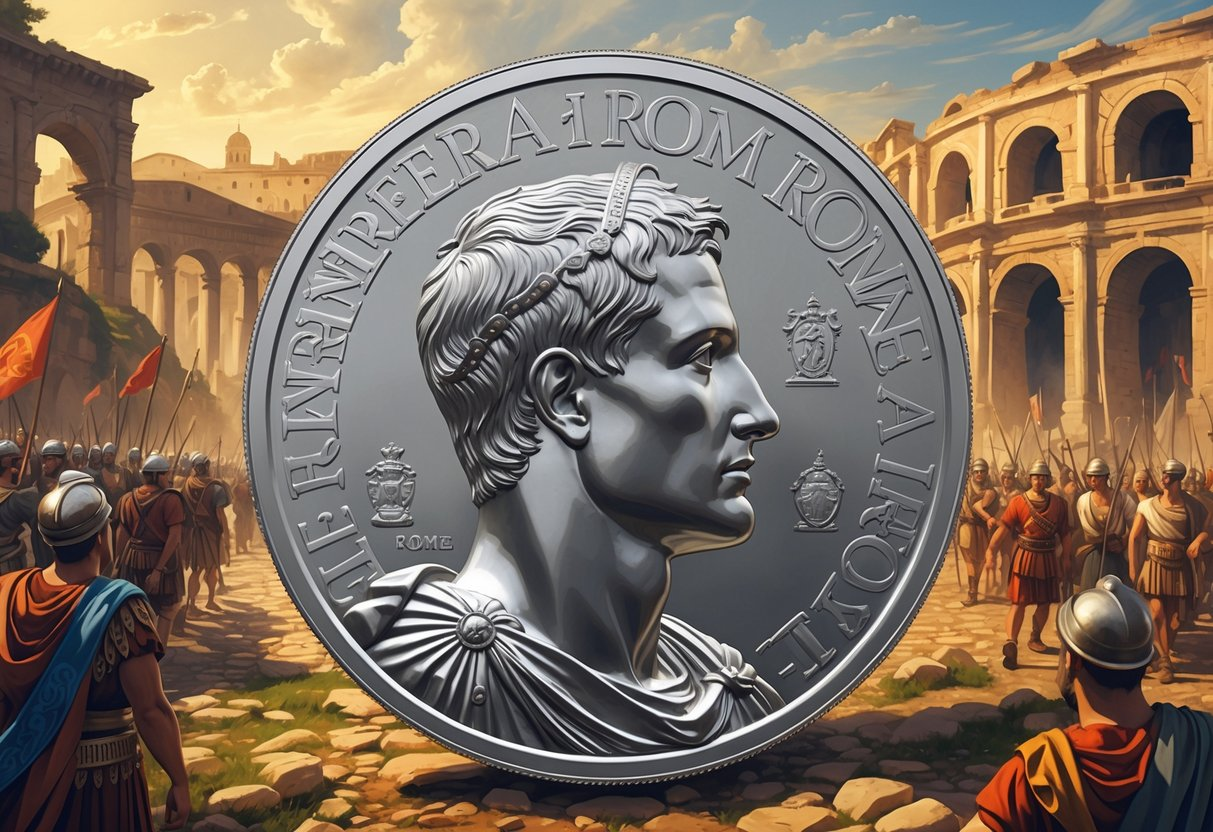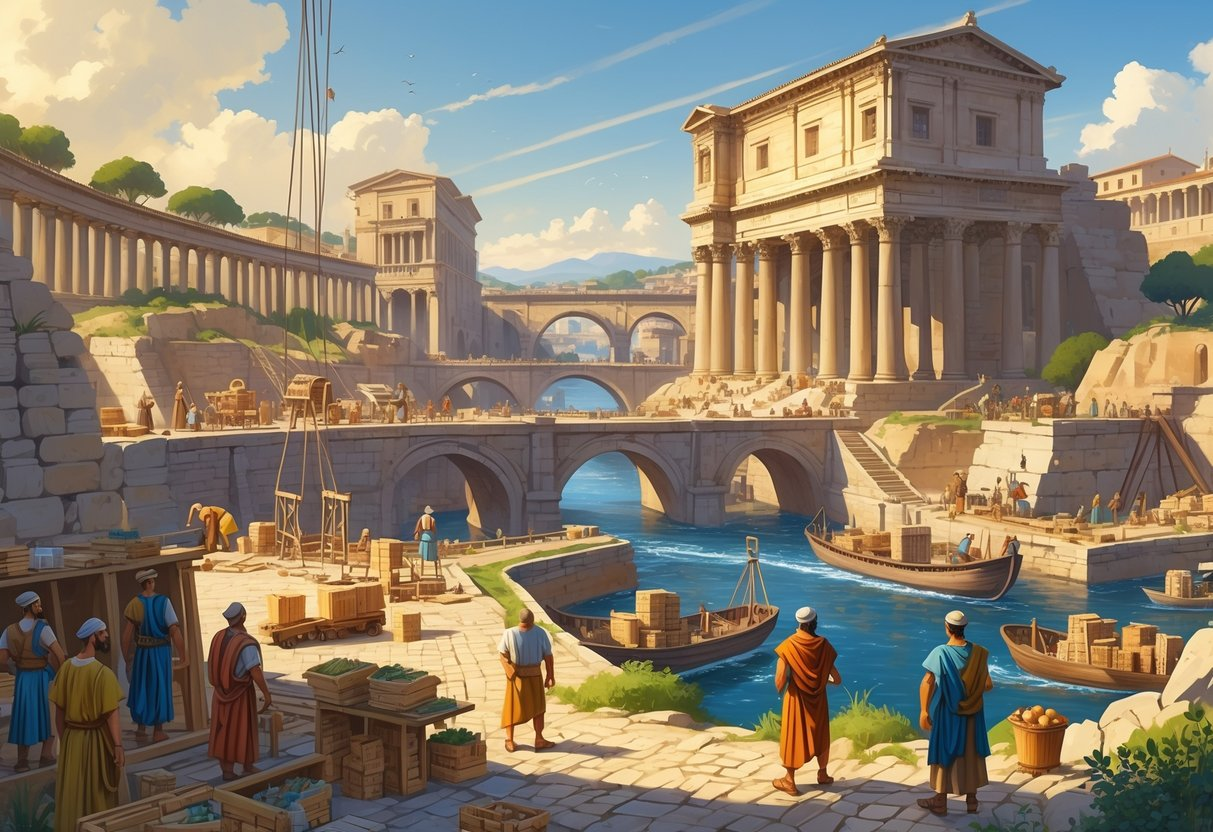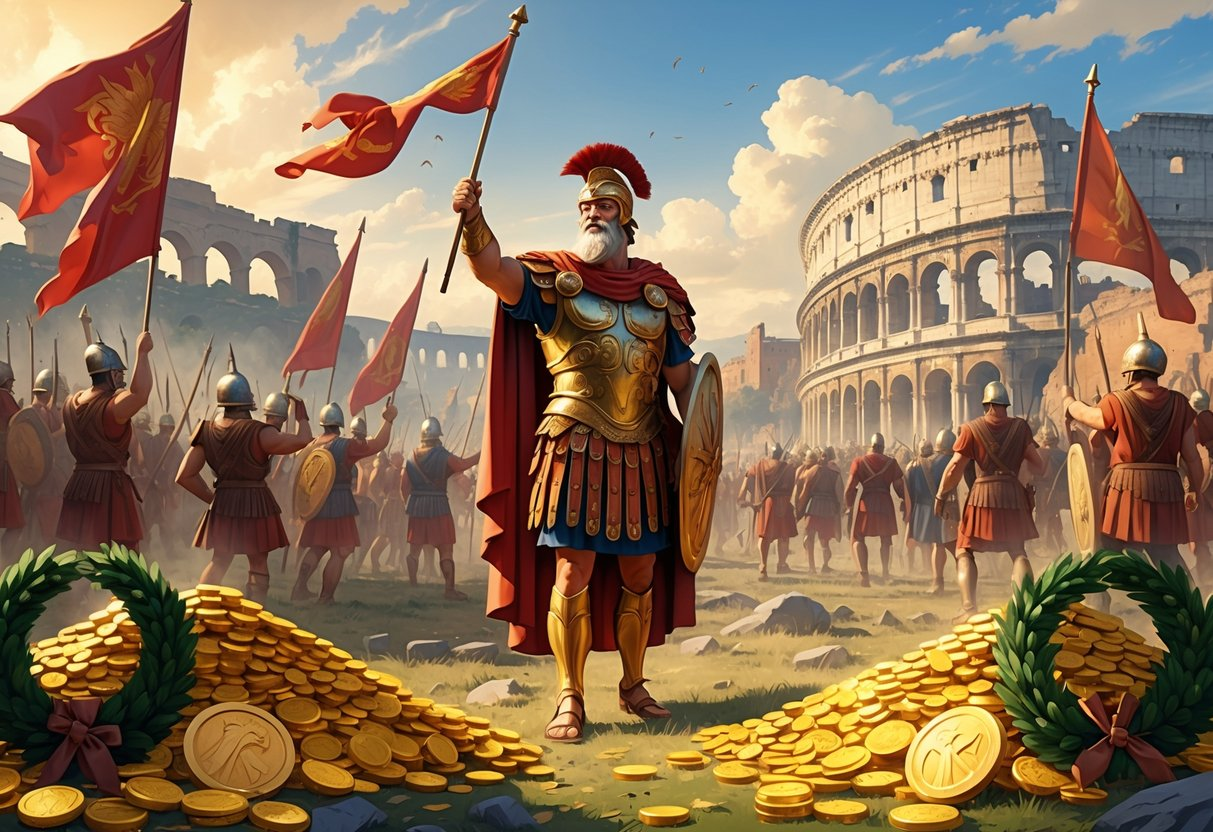The rise of ancient Rome wasn’t just about its armies or famous leaders—it was also about the silver coin that moved through every market and military camp.
The denarius became more than just money; it was a tool of power, trade, and trust.

As Rome expanded, its coinage system had to keep up with the demands of conquest, business, and governing new lands.
The creation of the denarius was a big moment, setting a standard that worked for both local trade and international deals.
Over time, changes in silver content and how coins were made showed the ups and downs of the Republic and the Empire.
The story of the denarius shows how money shaped politics, society, and the empire itself.
From its beginnings in the Republic to its changes under the emperors, Roman coins are a window into how economic decisions could make or break a civilization.
Origins of Roman Coinage and the Birth of the Denarius

Roman money started out as simple metal trading and eventually turned into a silver-based system that helped the Republic’s economy grow.
This shift was about both new tech and the need to fund wars, changing how Rome handled trade, taxes, and building its empire.
From Barter to Bronze: Early Roman Money
Before coins, Romans used barter and weighed chunks of bronze to pay for things.
These bronze lumps, called aes rude, were all different shapes and sizes, so people needed scales for every deal.
As trade picked up, this got annoying fast.
By the 5th century BC, Rome started casting bronze bars with symbols or pictures—these were called aes signatum.
They had designs like oxen, eagles, or gods, showing their official value.
The bars’ standard weight made trading a lot easier.
Later, Romans came up with aes grave—big, round bronze coins that were cast, not struck.
They had images like the biga or quadriga, tying the coins to Roman identity.
Moving from raw metal to marked coins set up a more organized economy and showed that the state was taking charge of making money.
The Influence of Greek and Campanian Coinage
Down south, cities like Neapolis and other Greek colonies were already using silver coins called didrachms.
These coins looked great and always weighed the same, which impressed Roman traders who used them for deals around the Mediterranean.
Rome started copying these ideas as they got more involved with those regions.
Early Roman silver coins even copied Greek styles, like the helmeted Roma head and chariots on the back.
The quadrigati—silver coins with Jupiter in a four-horse chariot—are a good example of this influence.
This mix of Greek and Roman traditions helped Rome get ready for a bigger economy that could handle expansion beyond Italy.
Aes Signatum, Aes Grave, and the Path to Silver
Switching from heavy bronze to lighter silver was a game-changer for Rome’s money.
Aes signatum and aes grave stuck around for local deals, but silver became key for paying soldiers and doing business with other countries.
Silver coins were easier to carry and accepted in lots of places.
The state minted them at the Temple of Juno Moneta—that’s actually where we get the word “money” from.
Tying religion to minting made people trust the coins more.
As Rome’s economy grew, silver took over as the main standard.
The Republic could now keep coins consistent in weight and purity, paving the way for the denarius to become the main Roman coin.
The Second Punic War and the Introduction of the Denarius
The Second Punic War (218–201 BC) made Rome rethink its money system.
Fighting Hannibal and supporting armies all over Italy needed a ton of resources, and the old bronze system just wasn’t cutting it.
In 211 BC, Rome rolled out the denarius, a silver coin worth ten bronze asses.
It quickly became the backbone of the Republic’s economy.
The denarius had the head of Roma and a quadriga (four-horse chariot) on the back, standing for victory and unity.
This new system made it easier to pay troops and allies, which boosted confidence in Roman money and helped trade and expansion.
The denarius kicked off a standardized money system that lasted for centuries.
The Denarius in the Roman Republic: Standardization and Expansion

The silver denarius brought Rome’s growing economy together by creating a reliable weight and value system, replacing the old bronze coins.
Its introduction made trade, taxes, and paying the army way easier, letting the Republic spread its influence around the Mediterranean with a currency people trusted.
Denarius Structure and Value: Asses, Sestertius, and Quinarius
The denarius showed up around 211 BCE as part of a big change in the Roman monetary system.
At first, it was worth 10 asses, but later it was bumped up to 16 asses because of inflation and the bigger role of silver.
The coin weighed about 4.5 grams of nearly pure silver, and that standard stuck around for a long time.
Other coins worked alongside it.
The quinarius was half a denarius, while the sestertius was a quarter.
This setup made it easy to buy everyday stuff or handle big state payments.
| Coin Type | Metal | Value in Asses | Fraction of Denarius |
|---|---|---|---|
| Denarius | Silver | 16 | 1 |
| Quinarius | Silver | 8 | ½ |
| Sestertius | Silver (later bronze) | 4 | ¼ |
| As | Bronze | 1 | ¹⁄₁₆ |
Standardizing everything made accounting and trade way simpler and made people trust Roman coins.
The design usually showed the helmeted head of Roma, standing for the Republic’s authority and unity.
The Role of the Denarius in Military and Economic Growth
The denarius was key to Rome’s military success.
Soldiers got paid in silver coins, which kept them loyal and let armies operate far from home.
This reliable pay system made big campaigns possible and helped bring conquered lands into the Roman economy.
Collecting taxes and handling state contracts also depended on the denarius.
As Rome grabbed new provinces, having one currency made it easier to collect taxes and buy supplies.
During wars, the mints worked overtime, showing how closely coinage and military logistics were tied together.
The denarius tied together soldiers, merchants, and provincial officials into one big financial network.
Symbolism, Propaganda, and Political Messaging
Roman coins weren’t just about money—they sent political messages, too.
Early denarii showed gods like Roma and Victory, showing off civic pride and that the gods were on Rome’s side.
Later on, moneyers started using coin images to promote their own families and political causes.
Big names like Julius Caesar even put their own faces on coins, which was a big break from old traditions.
This turned currency into a kind of propaganda, linking personal power to the stability of the Roman monetary system.
Coins also celebrated military wins, public projects, and alliances.
Since most people couldn’t read, these images helped shape public opinion.
Coinage reflected both political competition and Rome’s changing identity.
The Spread of Roman Coinage Across the Mediterranean
As Rome grew, the denarius pushed out local currencies across Italy, Spain, and the eastern provinces.
Its reliable silver content made it the go-to for trade and taxes.
Merchants and officials started using Roman coins for deals and debts, making economic life more connected.
In places with strong Greek influence, the denarius existed alongside Greek silver coins for a while, but eventually took over.
The disappearance of local currencies meant Rome was calling the shots.
By keeping weights and images consistent, the Roman Republic showed its authority through its coins.
The denarius became both a symbol of Roman order and a practical tool that tied distant markets together.
Transformation in the Roman Empire: Debasement, Crisis, and Reform
The Roman money system went from stable silver coins to a complicated mess of debased coins and constant reforms.
These changes showed the empire’s political problems, heavy military spending, and emperors trying to win back people’s trust in their money.
Imperial Portraits and the Power of Coin Imagery
Roman coins did more than just buy stuff—they spread the emperor’s image everywhere.
Starting with Augustus, every emperor put his face on coins to show he was in charge and connect with people all over the Roman Empire.
Portraits changed from idealized to more realistic, showing different ideas of what power looked like.
Coins were basically ancient mass media, spreading messages way faster than letters or decrees.
Inscriptions and symbols backed up the emperor’s image.
Victories, connections to gods, and big public projects showed up alongside the emperor’s face.
This kind of visual messaging helped keep far-off provinces loyal and reminded everyone who was boss.
As the empire grew, making coins became a tool for both ruling and sending out the imperial brand.
The emperor’s face on a denarius or aureus wasn’t just decoration—it was authority stamped in metal.
Debasement Under Nero and Successive Emperors
Under Nero, the silver in the denarius dropped from about 98% to around 93%.
This let Rome make more coins from the same amount of silver, which helped pay for building projects and the army.
Later emperors kept this up.
The denarius kept losing weight and purity as wars and government costs piled up.
By the second century, the denarius had less than 80% silver.
People started to lose faith in the coins, and prices went up.
Debasement was both a political and an economic move, showing that sometimes emperors went for quick fixes instead of real reforms.
The Antoninianus and the Crisis of the Third Century
In 215 CE, Caracalla introduced the antoninianus, a coin valued at two denarii but containing only about 1.5 denarii worth of silver. This move was meant to stretch the empire’s silver reserves and pay soldiers more without actually spending more.
At first, the antoninianus seemed to work. But pretty soon, it started losing credibility as its silver content dropped fast.
By the middle of the century, the coin’s silver content was below 5%. The Crisis of the Third Century—a time of civil war, invasions, and economic chaos—just made things worse.
Trade took a hit as prices shot up and people stopped trusting coins. According to Monetary integration in the Roman Empire, the rise of debased coins showed how the empire was struggling to stay unified.
Reforms of Aurelian and Diocletian
Aurelian (270–275 CE) tried to fix things by making coins better and standardizing minting. He added clearer value marks and cracked down on counterfeiters, showing that the government was taking control again.
Later, Diocletian (284–305 CE) went even further. He brought in the nummus, a big bronze coin with a thin layer of silver, and issued the Edict on Maximum Prices to fight inflation.
Diocletian’s coin system was tied to a fixed ratio of the Roman pound. This was an attempt to stabilize both the value of the metal and what people could actually buy with the coins.
His reforms showed a shift toward more government control over the economy. The empire was moving from a pure silver system to a mixed-metal one that could last longer.
Legacy and Global Influence of the Denarius
The Roman denarius had a huge impact on economic systems, language, and how people thought about money and power. Its silver standard and wide use set the stage for later currencies and even influenced modern money.
The Denarius and Modern Currencies
The Roman denarius became a model for coins and currencies all over Europe and the Middle East. Its reliable silver content and weight made it a trusted way to trade across the empire.
Many later currencies—like the Spanish dinero and the Arabic dinar—got their names and concepts from the denarius. Medieval rulers copied the idea, creating silver coins to help keep their own economies stable.
The denarius inspired European mints to make coins that looked Roman and followed similar rules. Over time, names like “denier” in France and “pfennig” in Germany came from the same root.
Historians point out that the denarius also influenced how governments connected currency to their own authority. As mentioned in Monetary innovation in ancient Rome, Rome’s early coin reforms tied money to state power—a concept that still matters for national currencies.
| Term | Origin | Modern Equivalent |
|---|---|---|
| Denarius | Latin | Dinar, Denier, Dinero |
| Aes Rude | Early Roman bronze | Base metal coinage |
| Denier | Medieval France | Cent-based systems |
Cultural and Linguistic Impact
The denarius left its mark on language and culture too. Words like dinar, denier, and dinero all come from the Roman coin, showing just how far its influence spread.
You can find these money words in modern Arabic, French, and Spanish, connecting today’s cash to ancient Rome.
Roman coins also set trends in design. Emperors started putting their faces on coins, which later rulers copied as a way to show off their power.
As described in A History of Ancient Rome in Twelve Coins, coins carried messages that connected people to the empire’s power.
Even now, the name “denarius” lives on in money words around the world. It’s a reminder of how much Roman ideas about money still matter today.
The Denarius as a Cautionary Tale in Monetary History
The denarius started out as a stable silver coin. Over time, though, it went through debasement—meaning the silver content was lowered, which made people trust Roman money less.
Economic historians, like those in Debasement and the decline of Rome, connect this to inflation and the empire’s money problems. Emperors kept reducing the silver to pay for wars and government stuff.
As a result, prices went up and people started losing confidence in the currency. The denarius’s decline is a good example of how messing with money can mess with a whole society.
Modern economists still look at what happened to the denarius as a warning. It’s a reminder that if you rely too much on printing money or lowering its value, even big economies can get into trouble.




Leave a Reply